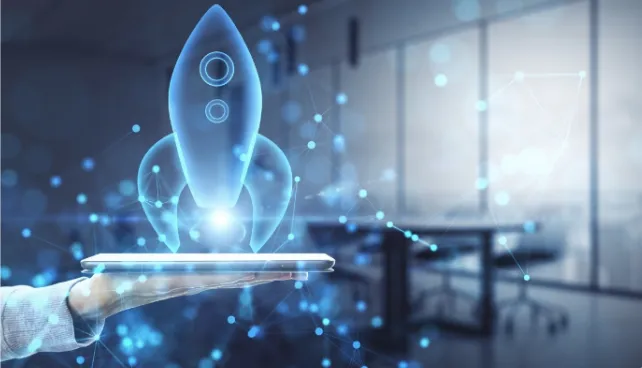Leveraging Sales Acceleration Technologies to Sell More and Sell Efficiently

It’s easy to understand why leveraging these sales technologies is critical to achieving B2B sales goals. Having said that, getting too many shiny new tools, without having a clear understanding of the right toolset will lead to overkill. Therefore, in sales, like in any other process, it is imperative to build the right balance between technology, process, and people.
As an investor and entrepreneur, sitting on both sides of the table, I do have a birds-eye view of the challenges faced by sales teams within fast-growing Startups. Among the most common challenges are lead quantity, lead quality and the technologies that they need to choose to increase sales velocity and predictability. Another well-known productivity challenge is that of salespeople spending too much time on administrative or non-selling activities. The question that arises then, is how do we leverage technology to efficiently drive B2B sales processes and maximize the time spent on the core selling process? The right set of well-integrated technologies can achieve exactly that.
Typically, a B2B sales process begins with a Marketing Qualified Lead (MQL) and ends at a Customer.

Through each of these stages, it is vital that the right sales tech solutions are in place to enable sales teams to get the highest lead to customer conversion rates and build lasting relationships with their customers.
Sales Technology Landscape

Contact Information
Building a strong contact list is the starting point in the sales process and data integrity is of utmost importance. This is why you need to consider well-established sources such as ZoomInfo and Hoovers which provide detailed and accurate contact information to form your prospect list.
Once we have led from the prospect list, your B2B Marketing department will qualify leads that are “hand raisers”. These are people who have shown interest in your products and are much more likely to convert to customers. It logically follows that these are the people that qualify for increased focus and effort of the team going forward. Marketing qualified leads (MQLs) that are accepted by the Sales team for further follow-ups and actions and become Sales Accepted Leads (SALs)
Sales CRM
The right CRM solution forms the heart of the sales technology landscape. This is where contacts and leads are organized, interactions are tracked and sales opportunities are monitored through the pipeline. Pipeline management is an important process in this stage as a cluttered pipeline will spread the attention of the sales rep too thin. Also, it becomes essential to have a clearly defined lifecycle of the prospect from lead to closure. This is what the sales pipeline accomplishes in a visual way.
Once we have the contacts organized in the CRM, the next key step would be to understand a customer’s buying decisions and to create the B2B buyer personas. This is what your typical customer would look like in terms of role, behavior, what motivates them, etc. The personas add value to the sales funnel when contacts in the CRM are assigned to them. Then by tracking buyer persona activity in the CRM, one can identify patterns and trends around specific segments and devise the sales strategy accordingly.
Being the core of the sales tech stack, the CRM solution allows all individuals in the company involved in sales from field reps and operations to team leaders and managers to collaborate and stay on top of their tasks. Analytics provided by the CRM tool allows the senior management to review team performance, pipelines, and forecasts so they can decide where to focus their energies.
As we shall see further, integrating the Sales CRM with the right set of tools will provide a 360-degree view of your customer and much more knowledge on how to handle every sales lead. Some of the most popular CRM solutions include Salesforce.com, Hubspot, Zoho, and SugarCRM.
Sales Acceleration
By this stage we have the contacts organized, leads qualified and the forecasts and sales strategy in place. The question now is how do companies accelerate the sales process? This is where sales acceleration technologies help by increasing the velocity of sales and making the entire process much more efficient and effective. This is done through innovations in sales communications, predictive analytics, data visualization, pricing and quoting tools, prioritization, recommendations and email tracking for well-timed emails.
While we are busy focusing on technology related to the core sales process, let’s not forget that the success of any sales team is as good as its salespeople. A motivated and engaged sales team then becomes imperative to achieving organizational goals. Enter, gamification tools provided by sales accelerators. Infusing a game-like experience in everyday tasks can help drive new levels of employee motivation and thus boost existing sales performance.
Examples of sales acceleration tools include Sidekick, InsideSales.com, CallidusCloud, etc. Yesware is another popular tool that tracks email, helps create email templates and schedule meetings. Sales Cloud Einstein from Salesforce also makes intelligent predictions and recommendations about deals.
Sales Forecasting
Sales forecasting and analytics are an integral part of business management. Rather than shooting in the dark, being able to better predict the outcomes of sales cycles allows the business to take action where necessary forms a strong basis for future planning. This is where solutions like DataHug come into play. Datahug also helps organizations collaborate better around the people inside a company in order to simplify the sales or deal flow process, and the whole team benefits from the transparency. InsightSquared is another tool that automatically generates multiple forecast models and can produce analytics around pipeline activity over any time period.
In addition to Sales forecasting, most CRMs also integrate with Sales Performance Management software that is also a key ingredient in helping more people hit their quota. It helps record and manage sales performance on a team and individual basis.
Data Enrichment and Intelligence
Sales intelligence is that insight into the data that allows for a highly targeted approach to selling. The sales team needs to understand everything about the customer’s industry, the specific business, and technology issues as well as individual stakeholder dynamics to further evolve and personalize the sales pitch. Hence, we need to leverage competitive intelligence platforms like Owler, insights into a company’s technology stack with tools like HG Data and social intelligence from tools like LinkedIn sales navigator for engaging directly with decision-makers.
Getting to really know the customer, what they’re needs are, what motivates them, how you’re connected to them and other intelligence will surely elicit a better response. At this point, high-quality data becomes really important. Software tools like InsideView use machine learning algorithms and artificial intelligence to produce this accurate and actionable B2B data and intelligence.
The Bottomline
It’s easy to understand why leveraging these sales technologies is critical to achieving B2B sales goals. Having said that, getting too many shiny new tools, without having a clear understanding of the right toolset will lead to overkill. Therefore, in sales, like in any other process, it is imperative to build the right balance between technology, process, and people for a thriving and high-performance sales organization.







